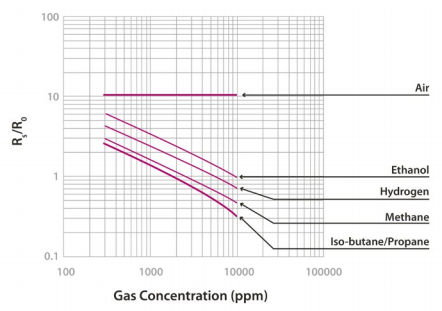Sidebar
Table of Contents
Waspmote Liquid Petroleum Gases Sensor
Quick Data
- Model: Figaro TGS2610
- Gases: Primarily Isobutane. Also sensitive to Methane, Ethanol, Hydrogen
- Measurement range: 500 ~ 10000ppm
- Resistance at 1800ppm (isobutane): 0.68 ~ 6.8kΩ
- Sensitivity: 0.56 ± 0.06 (ratio between the resistance at 3000 and at 1000ppm)
- Load resistor: 10kΩ, Gain: 1, Supply voltage: 5V DC
- Some approximate gas ppm levels for reference
- Iso-butane/Propane
- Lower explosive limit (propane): 21000ppm
- Higher explosive limit (propane): 104000ppm
- Dizziness to asphyxiation: >100000 ppm (non-toxic - purely due to oxygen displacement)
- Methane
- Lower explosive limit: 50000ppm
- Higher explosive limit: 150000ppm
- Dizziness to asphyxiation: >100000 ppm (non-toxic - purely due to oxygen displacement)
- Ethanol
- Lower explosive limit: 33000ppm
- Higher explosive limit: 190000ppm
- Adverse Effects: 1000 ppm
- Hydrogen
- Lower explosive limit: 40000ppm
- Higher explosive limit: 750000ppm
- Adverse Effects: 10 ppm
- Life Threatening: >150 ppm
Conversion Method
Converting to Concentration of Liquid Petroleum Gases in Air (parts per million)
The output of the waspmote to the database is a voltage reading, as can be seen from the circuit diagram below, this reading is affected by the input voltage, sensor resistance and load resistance.
To convert to ppm, the voltage reading is applied as follows
Step 1. Convert voltage reading to sensor resistance: Rs = ( ( Vcc - Vout ) / Vout ) * Rl
Step 2. Determine sensor resistance at 1800ppm (isobutane) Ro. If there is insufficient data at this stage to do this empirically, begin approximation by using the lower extreme of the expected sensitivity provided in the datasheet ~ 0.68kΩ
Step 3. Normalise against resistance at 1800ppm (isobutane): Rs / Ro(Typical Resistance at 1800ppm (isobutane)
Step 4. Compare normalised result against sensor response diagram:
Sensor Response Characteristics
Example
Measurement of 3.3v is observed (from our databases).
- Rs = ( (5 - 3.3) / 3.3) * 10000
- Rs = 5152
- Normalised = Rs/Ro = 5152/680 = 7.58
- Normalised resistance = 7.58. This does not intersect with any gases and lies near the clean air value of 10, as would be expected.
Notes
- A standard Rs/Ro should read between 6 and 10, since this sensor only detects large and dangerous concentrations.
- If your Rs/Ro value intersects multiple gases on the response graph, it is impossible to determine which gas or gases the sensor is responding too without extra equipment.


